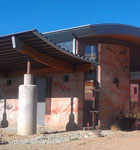The Scene
Eighty miles north of Phoenix, Peeples Valley is a Southwestern high-desert ecology that has snow in the winter and hot summer days exceeding 100 degrees Fahrenheit. Not far from Prescott National Forest, it is a dynamic region of rolling pastureland and pinyon and ponderosa pines. And it is this general locale that Living Systems Sustainable Architecture and Building Group has called home since the early 1970s, making a name for itself through the use of earthen high-mass construction methods. These tactics were employed most recently for an off-the-grid home on 67 acres in Peeples Valley.
The Setup
Led by Michael Frerking and John Lutes, Living Systems got its start with adobe, transitioned to rammed earth, and has since established itself as an industry leader and advocate for poured-earth technologies. Poured earth is similar to rammed earth in that it reuses the soil from the building site but is more similar to concrete in use. However, it displaces up to 80 percent of concrete’s Portland cement with flyash, substantially reducing the building’s carbon footprint. Frerking and Lutes saw the Peeples Valley project as a continuing challenge and opportunity to evolve their net-positive, or “net plus,” philosophy.
The Strategy
Properly designed high-mass, poured-earth homes minimize—and can potentially eliminate—the energy required for heating and cooling, Frerking says. “Considering its advantages, the biggest challenge today facing poured earth is education,” he adds. “People need to understand that the primary difference between poured earth and concrete is the use of clay and low- to no-carbon-emitting binders, rather than Portland cement.”

An example of Living Systems' innovative desert building. Many homes are built with poured earth, a mixture similar to concrete but that replaces Portland cement with more sustainable materials.
Poured earth is able to use site soils to build walls just as builders use site resources such as the sun, wind, and rain to heat, cool, and provide power and water. At the same time, the strategy builds upon the concrete industry’s huge infrastructure to mix, deliver, form, and place the product. “We see poured earth as a ‘green bridge to sustainability’ for the concrete industry,” Frerking says, “and as such find the concrete industry very supportive in working with us.”
In addition to poured-earth walls, the Peeples Valley residence uses four inches of exterior foam to encapsulate heat and naturally maintain a comfortable temperature. Nighttime radiative cooling uses pool solar mats to chill water at night for radiant-floor cooling, and radiant heat comes from solar hot-water panels. Rainwater-management systems capture, store, and purify water while solar-reflector decks create diffused daylighting for comfort and energy distribution to the building mass.
According to Frerking, the critical distinction with this project and many others deploying a handful of sustainable components is the focus on being a net-positive home. “From the use of site soils for walls to the extensive water-management techniques deployed, we have gone beyond the concept that green homes are less harmful to the environment than others,” he says. “Our goal is to build structures capable of creating more energy and water than we use in the production and operation of the home. We are rediscovering our importance to the nature around us and [how] to be a positive asset within the environment.”
Frerking says the key to creating net-positive homes is his company’s dedication to training, building, maintaining, and constantly developing solid relationships with building trades. “Presently LEED does not have specific certification programs for the people that physically construct ‘green buildings,’ such as plumbers, electricians, framers, etc.,” he says. “They are the unsung heroes of green.”
As an architect and general contractor, Living Systems has a unique ability to bring trades together and achieve a high level of synergy, Frerking says, explaining that the result is that people take ownership of the project and that bids are often 10–20 percent lower. “It makes a difference when you work directly with people who love what they do and have the ability to provide input from design through construction,” he says. “Jeremy and Jake Cluff of J.Co. Contractors are a prime example of this. As our poured-earth wall builders, we provide them with mix designs and quality control so that they know they will be efficient in forming and pouring the walls, resulting in a competitive bid that allows us to compete with other wall-construction alternatives.”
Looking ahead, Lutes and Frerking are excited about getting involved in larger developments locally, nationally, and internationally. “We need to demonstrate the economies of scale associated with our poured earth coupled with the ‘net plus’ approach,” Lutes says. “The advantage we provide is our ability to work closely with the full circle of skilled people including financiers, engineers, code officials, green-product suppliers, and project owners who all contribute in creating cutting-edge projects that serve them, their communities, and global sustainability.”

